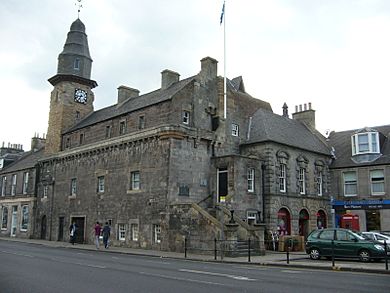Tolbooth facts for kids



A tolbooth or town house was a very important building in a Scottish town, called a burgh, from the Middle Ages until the 1800s. It was like the town's main office. A tolbooth usually had a room for the town council to meet, a court where judges made decisions, and a jail. The tolbooth was one of three key things every Scottish burgh needed, along with the mercat cross (a market cross) and the kirk (church).
Contents
Where Did the Name Come From?
The word "tolbooth" comes from an old English word, tolbothe. This word described a town building that had offices for collecting taxes or fees (called customs) and also prison cells.
A Look Back in Time: History of Tolbooths
Towns called burghs started appearing in Scotland in the 1100s. These towns had the right to hold markets and collect taxes or fees on goods. Tolbooths were first built to help collect these payments.
Royal burghs were special towns ruled by an elected council. This council was led by a provost and baillies. These leaders also acted as magistrates, which means they were like judges for local crimes. The tolbooth became the main building where all these important jobs happened.
Most tolbooths had a bell, often placed in a tall tower called a steeple. Later, clocks were added to these towers. Besides holding people accused of crimes or those who owed money (called debtors), tolbooths were also places where people who broke the rules might be punished in public.
Sometimes, the tolbooth also served as a guardhouse for the town's security. Other things that happened in different tolbooths included:
- Schoolrooms for children
- Weighing stations for goods
- Storage for important equipment and records
- Places for entertainment
The first time a tolbooth was mentioned was in Berwick upon Tweed in the late 1200s. The earliest known land given for building a tolbooth was in Dundee in 1325. Many more such grants were recorded throughout the 1300s.
The oldest tolbooths that are still standing today are in Musselburgh (built in 1590) and Canongate (built in 1591). The tolbooth in Glasgow (built in 1626) was a very famous building in the 1600s. Other tolbooths built in a similar style were in Linlithgow (1668) and Kirkcaldy (1678).
By the 1700s, the word "tolbooth" started to be mostly linked with prisons. So, the term "town house" became more common for the main town buildings. New styles of architecture, like the classical style, were used for buildings such as the ones in Dundee (1731) and Sanquhar (1739).
In the early 1800s, different jobs started to be done in separate buildings. Special courthouses were built for trials, and separate prisons were built for holding people. This led to tolbooths and town houses being replaced by modern town halls. These new town halls were used for council meetings and events. Even though most prison jobs moved, the jail cell in the Falkirk Steeple was still used until 1984!
Tolbooths Today
There are about 90 tolbooths still standing in Scotland. Many of them are still used as town buildings. Others have been fixed up and turned into museums, theatres, or other fun places to visit.
Here are some famous tolbooths:
- Aberdeen Tolbooth, built in 1629
- Canongate Tolbooth, built in 1591
- Crail Tolbooth, changed in 1776
- Dysart Tolbooth, built in 1576
- Edinburgh Tolbooth, an old building on the Royal Mile, built around 1400, but taken down in the 1800s
- Girvan Tolbooth, built in 1787, only the steeple (tower) is left
- Glasgow Tolbooth, built in 1627, only the steeple (tower) is left
- Inverkeithing Tolbooth, built in 1770
- Kirkcudbright Tolbooth, built in 1629, now an art gallery and visitor center
- Lanark Tolbooth, built in 1778
- Musselburgh Tolbooth, built in 1590
- New Galloway Tolbooth, rebuilt in 1875 but from at least 1711
- Pittenweem Tolbooth, built in 1588
- Sanquhar Tolbooth, built in 1739
- South Queensferry Tolbooth, changed in 1720
- Stirling Tolbooth, built in 1705
- Stonehaven Tolbooth, built in the late 1500s
- Tain Tolbooth, built in 1708
- West Wemyss Tolbooth, built around 1700
See Also
- Tholsel, a similar type of building in Ireland
- Tron, a weighing device often found near tolbooths to help with taxes on goods

